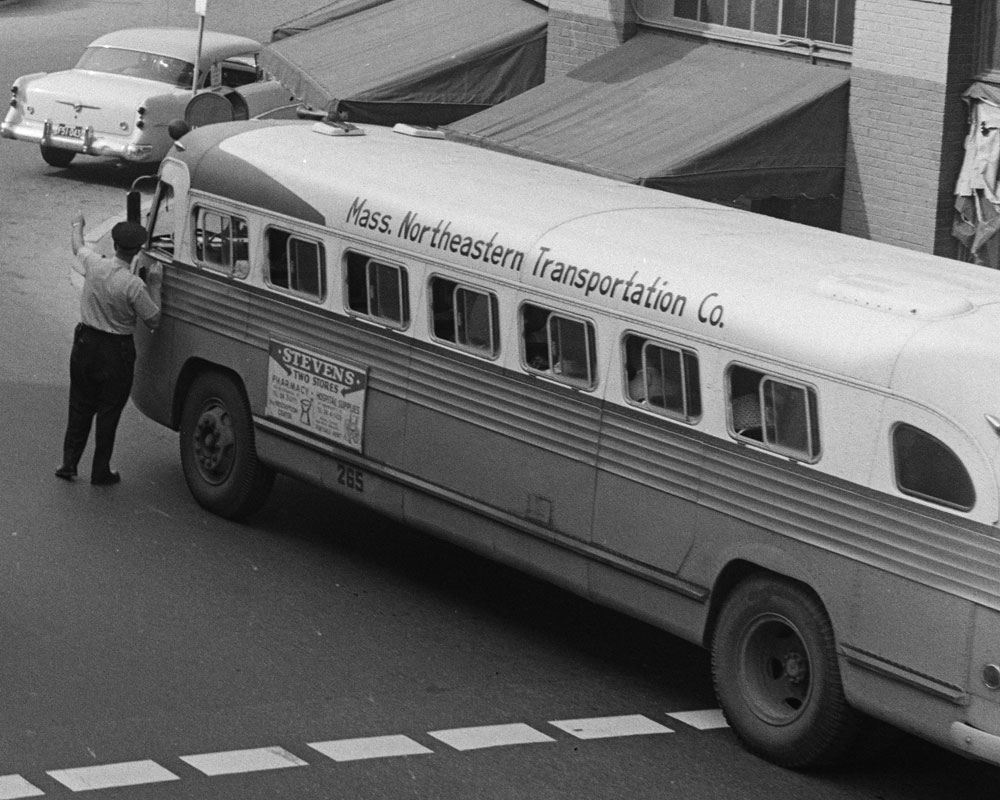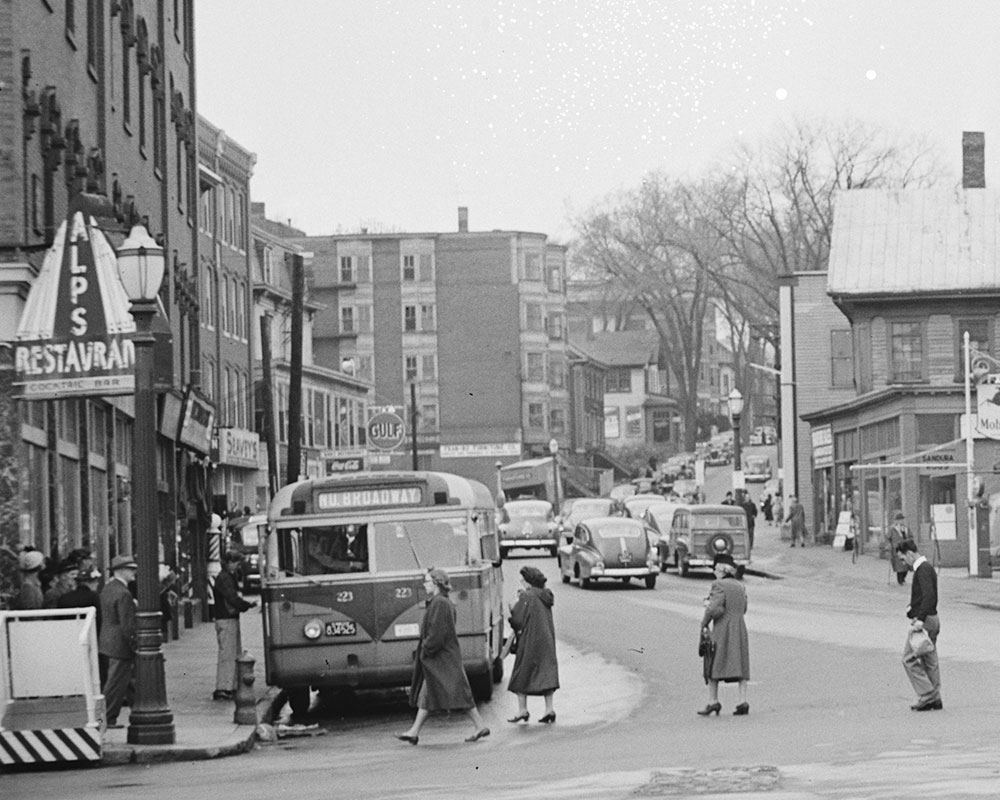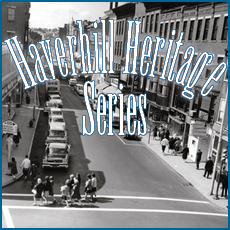‘Music as You Ride’ Fails to Save Original WHAV-FM in 1952
Editor’s note: A version of this story originally appeared in a WHAV newsletter May 17, 2010. Additional photograph below.
The original FM incarnation of WHAV was a relatively short-lived affair of about only four years. It was conceived under difficult circumstances, lived in painful agony and died in part because of complaints from, of all people, bus passengers.
WHAV FM was supposed to be Haverhill’s first radio station and would have been one of the first FM stations in the northeast. The Haverhill Gazette began planning an FM station as early as 1944, but it would not go on the air for another four years. First, the Gazette had to wait for the end of World War II and then delivery of consumer receivers after the Federal Communications Commission abruptly moved the FM band from a lower set of frequencies to where it is today. The Gazette was forced to first launch an AM station.
“…establishment of an AM station for local coverage does not mean the company has abandoned plans for its FM station. It was decided to apply for an AM station when it became apparent facilities were not going to be developed as fast as first believed possible for FM stations,” Gazette Publisher John T. “Jack” Russ announced in 1946. WHAV’s AM signal officially signed on March 16, 1947.
The launch of WHAV-FM a little more than a year later still was not the end of the battle. It was actually only the beginning. Placing a 20,000-watt FM station on the air was an expensive undertaking, requiring generous advertising revenues to maintain. The Gazette could not attract the then-major networks — NBC, CBS, ABC or Mutual — to help foot the bill. Instead, it turned to the Continental Network, a new chain of FM stations created in 1947 and supported by Edwin Howard Armstrong, the inventor of FM. Alas, the network never attracted interest outside of the northeast and folded when Armstrong committed suicide in 1954.
Next, WHAV-FM tried the new Liberty Broadcasting System, whose programming largely centered on recreating baseball games. It folded in 1952.
Reaching Out to ‘Captive’ Audiences
One last hope for WHAV-FM came from a new commercial entrant, Transit Radio. The company was formed originally to provide “music as you ride” from WWDC-FM to Washington, D.C., bus lines operated by Capital Transit Co. FM radio receivers were placed in buses and streetcars, and riders were forced to hear music, time signals and commercials. Eventually, FM radio stations and commuter lines across the country took part. Locally, commercials aired over WHAV-FM and were heard over loudspeakers on area bus lines—presumably Massachusetts Northeastern Transportation Company, believed to be a direct ancestor of today’s MeVa Transit. Transit Radio made money by selling equipment to commuter lines and advertising to sponsors.
Profits were shared by all parties. In fact, the Feb. 26, 1949 issue of Billboard reported the rapid growth of Transit Radio with major advertising commitments from Household Finance Corporation and General Mills. WHAV-FM finally was making money.
Some bus riders, however, were indignant. Even the “father of radio,” Lee deForest, slammed the activity in a 1952 Popular Mechanics article.
“Almost incredible is the loathsome fact that already in 21 cities bus riders must listen to never-ending, blatant advertising and unwelcome jitterbug and bop music, ‘viciously repugnant to the spiritual and intellectual assumptions of American life,’ as Prof. Charles Black of Columbia University wrote. This outrage is unquestionably the all-time low to which radio broadcasting can sink.”
Commuter Franklin S. Pollak of Washington, D. C. complained that he was held captive to hearing commercials and the service made it difficult to read or hold a conversation while riding. He and others unsuccessfully filed suit in U.S. District Court against the Public Utilities Commission of the District of Columbia which had regulatory authority over the more than 200 Washington, D.C. buses.
On appeal, however, the United States Court of Appeals, District of Columbia Circuit, sided with passengers June 1, 1951.
“Some discomforts may perhaps be inevitable incidents of mass transportation, but forced listening is neither incidental nor inevitable. It deprives the appellants and other passengers who object to the broadcasts of their liberty for the private use of Transit, Radio, and passengers who like the broadcasts. This loss of freedom of attention is the more serious because many people have little time to read, consider, or discuss what they like, or to relax. The record makes it plain that the loss is a serious injury to many passengers. They suffer not only the discomfort of hearing what they dislike but a sense of outrage at being compelled to hear whatever Transit and Radio choose.”
An appeal to the highest court in the land could offer one last chance for WHAV-FM, but would the body even agree to hear such a case? Surprisingly, the U.S. Supreme Court did from March to May of 1952 because of what justices called the “novelty and practical importance to the public of the questions involved.”
Writing for the majority, Associate Justice Harold H. Burton disagreed with the lower court. “The liberty of each individual in a public vehicle or public place is subject to reasonable limitations in relation to the rights of others. This Court expresses no opinion as to the desirability of radio programs in public vehicles…the situation is not unlike that which arises when a utility makes a change in its running schedules or in the locations of its stops in the interests of the majority of the passengers but against the vigorous protests of the few who are inconvenienced by the change.”
Court of Public Opinion Proves More Powerful
Despite victory in the Supreme Court, advertisers began to distance themselves from captive audiences. In its June 1, 1953 issue, Time magazine reported:
“At one time, it seemed to Transit Radio Inc. like a fine idea. With busloads of hapless passengers as audiences, music—and commercials—could be broadcast in urban buses all over the U.S. The plan was fought by groups of indignant passengers, by newspaper editorials and magazines (notably The New Yorker), all charging that bus broadcasts were an invasion of the bus rider’s privacy. Last year the company won a favorable Supreme Court decision and thought its troubles were over. But the bus-riding public and the nation’s advertisers combined to overrule the Supreme Court.”
WHAV-FM was finished. The Haverhill Gazette shuttered the outlet and sold its transmitter to Charles River Broadcasting, operator of WCRB AM 1330 in Boston, which put an FM station on 102.5 FM in 1954.
Perhaps Associate Justice William O. Douglas’s dissenting opinion on the matter summed up the the original complaint. He wrote, “The right to be let alone is indeed the beginning of all freedom.”
Incidentally, today’s WHAV has not asked MeVa Administrator Noah Berger to pipe WHAV on to buses but, tongue-in-cheek, what do you think Noah?

Haverhill Police officer talks with Massachusetts Northeastern Transportation Co. bus driver in Lafayette Square. (Courtesy of the Trustees of the Haverhill Public Library, Special Collections Department.)


